| Features |
| More people hit the road for this year's Spring Festival holiday | |
|
|
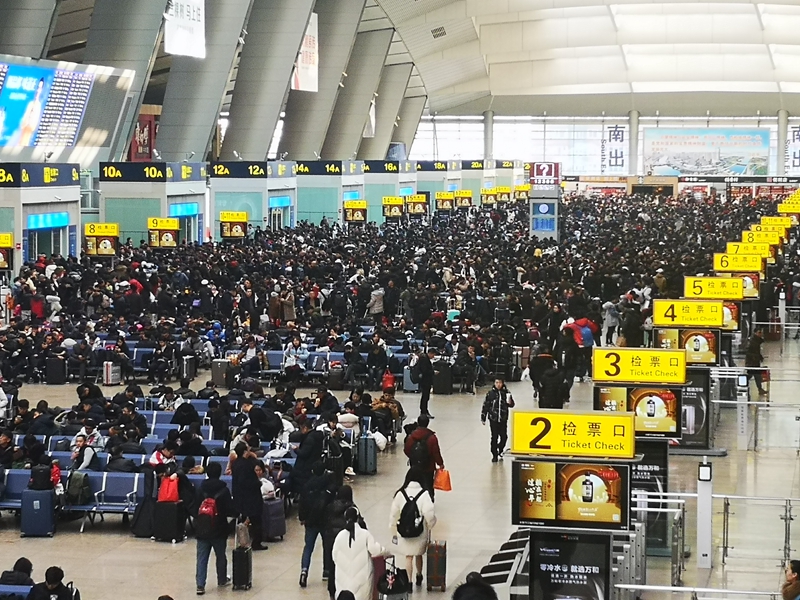 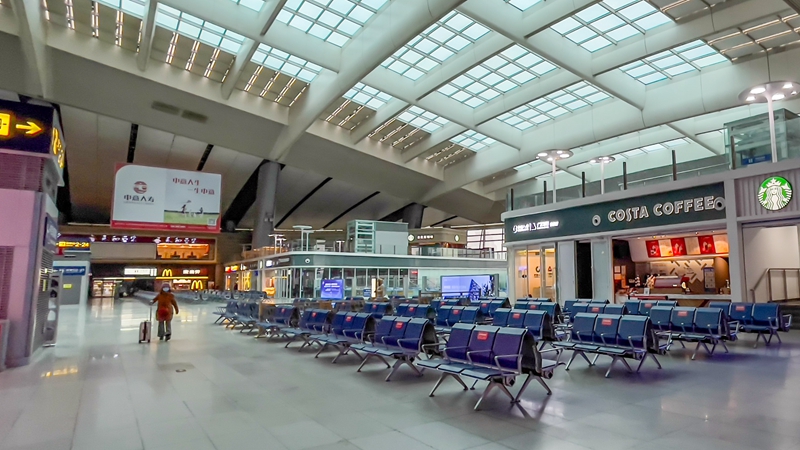 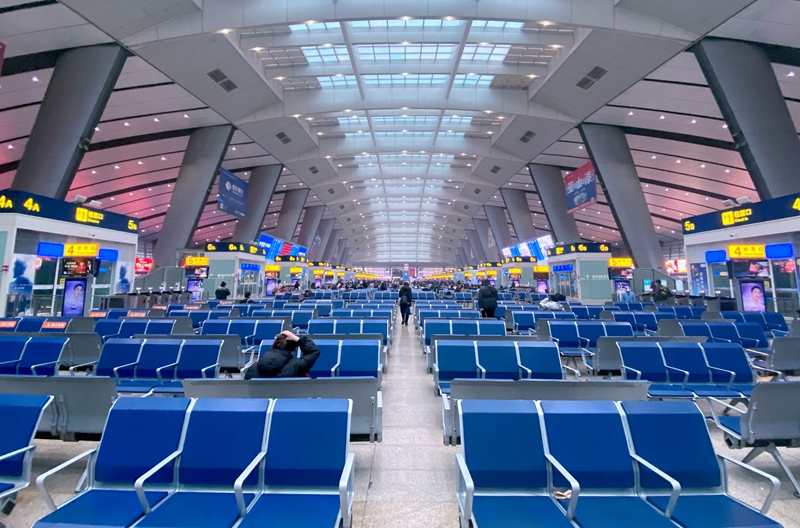 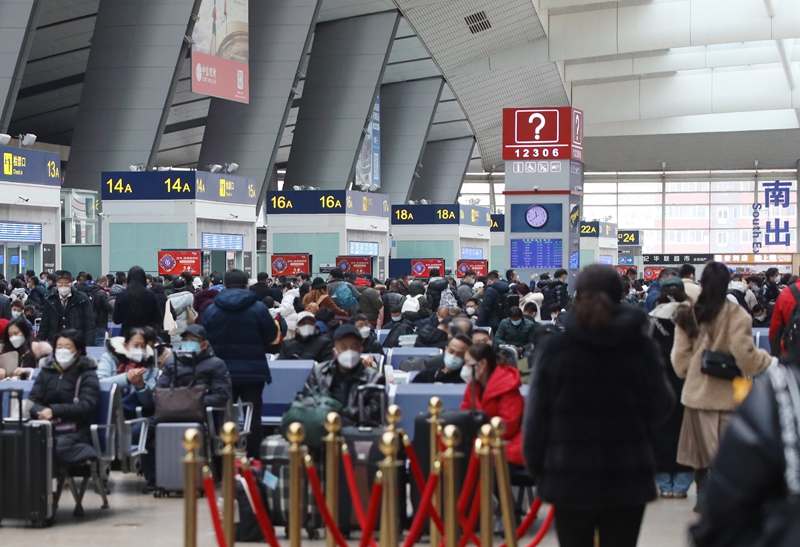 Waiting hall of the Beijing South Railway Station during the Spring Festival travel rush in 2020, 2021, 2022 and 2023, respectively (from 1 to 4)
Wei Lili, a woman who delivers milk to households with her husband in Beijing, hadn't been back to her hometown in Shanxi Province for three years, owing to travel restrictions imposed to control the spread of COVID-19. This year, as China has optimized its pandemic control measures and lifted travel restrictions, she booked two train tickets to her hometown well in advance for a reunion with her children and other family members to celebrate the Chinese New Year, or Spring Festival, which fell on January 22.
Wei has two daughters: One is around 20 and the other is 5. When her younger daughter was only 6 months old, Wei came to Beijing with her husband to work and left her children in the care of her parents-in-law. Before the pandemic, she had returned home every year for the Spring Festival. On Spring Festival Eve, she used to make dumplings while watching the annual Spring Festival Gala broadcast by China Central Television with her family. "I have been longing to go home for a long time and am counting the days till our departure. My family members are also very happy knowing we are going home this year," Wei told China Business Herald News Weekly in the days before she left Beijing. "I want to share the housework with my parents-in-law and take my children to visit local scenic spots during the festival," she said. Wei added she also wants to take a family portrait this year and bring it back to Beijing after the holiday. Zhang Guibo, who works for an air compressor company in Taizhou, Zhejiang Province, also hadn't returned to his hometown for the Spring Festival for three years for similar reasons. After the relaxation of these restrictions, travelers now no longer need negative nucleic acid test results to catch planes, trains and buses, and no longer need to go through test and quarantine on arrival at their destinations. Owing to the easing of restrictions, Zhang decided to go back for a visit. He arrived at Taizhou West Railway Station before 6 a.m. on January 7, took a six-hour train to Jinan, capital of Shandong Province, and then a three-and-a-half-hour bus to his home in Linyi County of Dezhou in Shandong. He took back with him Taizhou specialties including brown sugar and dried salted fish for his parents and told Dazhong Daily that he wants to make some dishes using the fish for his family during the festival. "I am really homesick after all the years of working away from home and I want to spend more time with my family during this year's festival," Zhang said. There are a huge number of people like Wei and Zhang who are returning home for the Spring Festival after a three-year separation. The mass mobilization of Chinese people returning home for the holiday, known as chunyun, usually lasts around 40 days. This year, it started on January 7 and is expected to end on February 15. 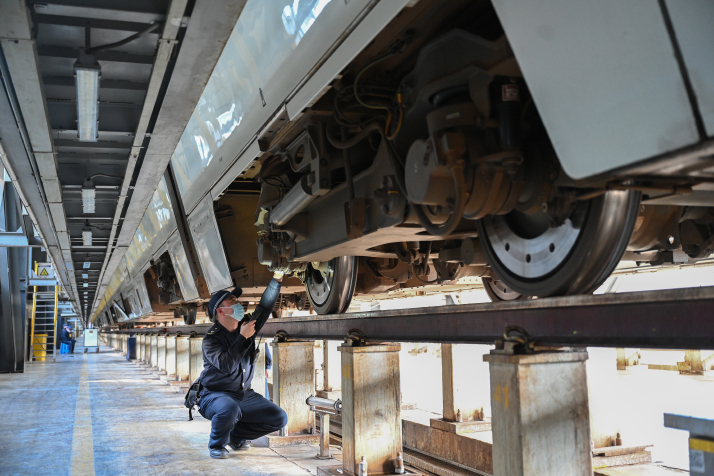 A staff member inspects a high-speed train in Fuzhou, Fujian Province, on January 7 (XINHUA)
Well-prepared On January 7, 34.74 million passenger trips were made across China, an increase of 38.9 percent over the first chunyun day of last year, according to the Ministry of Transport (MOT). However, the number was still 48.6 percent lower than that of the first chunyun day in 2019. In 2019, prior to the emergence of COVID-19, nearly 3 billion passenger trips were made during the 40-day period. However, beginning in 2020, people have been encouraged to avoid traveling during the festival to prevent infection. As a result, just 1.05 billion trips were made during the travel rush for the festival in 2022, only 870 million were made in 2021, and 1.5 billion were made in 2020. About 2.1 billion passenger trips are expected to be made during this year's chunyun period, a year-on-year increase of 99.5 percent, Vice Minister of Transport Xu Chengguang said at a press conference on January 6, while introducing preparations authorities had made for the 40-day travel rush. The volume of passenger trips is expected to be around 70.3 percent of the total in 2019, Xu said. The railway and civil aviation sectors have taken a series of measures to guarantee transportation capacity during the travel rush. "A daily maximum of 6,077 pairs of passenger trains have been scheduled to operate in the lead-up to the Spring Festival, and a daily maximum of 6,107 pairs for the post-festival period," Huang Xin, Deputy Director of the Passenger Transport Department of the national railway operator China State Railway Group, said at the press conference. About 11,000 flights have been scheduled on average for each day of the travel rush period, about 73 percent of the volume during the same period in 2019, Wan Xiangdong, chief pilot of the Civil Aviation Administration of China, said at the press conference. Airline companies have been encouraged to schedule more domestic flights to meet the increasing demand for travel from Beijing, Shanghai and Guangzhou in Guangdong Province, to Sanya and Haikou in Hainan Province, Chengdu in Sichuan Province, and Chongqing Municipality, Wan said. Wan said the flight schedule would be adjusted according to passenger demand and changes in weather to reduce the inconvenience caused by flight delays and cancellations. Although China has optimized its COVID-19 management and lifted travel restrictions, pandemic prevention and control is still very important during the travel rush as the huge migration of people and large logistic flows increase the risk of infection. "Disinfection and ventilation of airports, train and bus stations, expressway service areas and transportation tools will be improved," Cai Tuanjie, head of the Transport Service Department of the MOT, said at the press conference. "We should be prepared for large-scale infections of staff members in the transportation industry and ensure that there will be people to take over their work when staff begin to show symptoms such as fever," Cai said. Every passenger should be responsible for their own health by wearing masks and avoiding public transport when ill, he added. 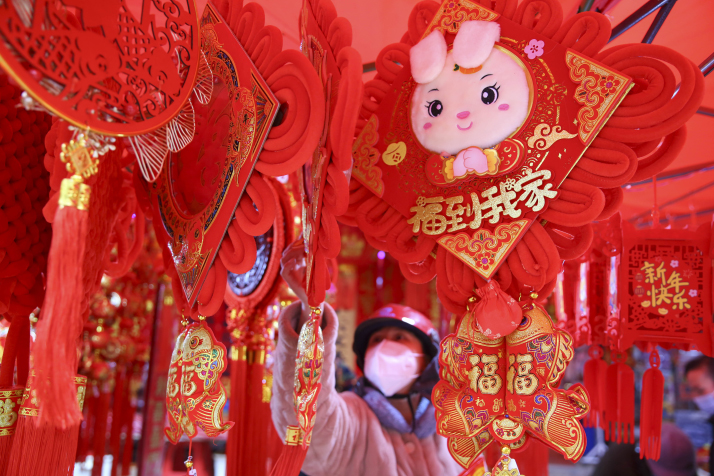 A woman picks out Chinese New Year decorations at a store in Longhui County, Hunan Province, on January 16 (XINHUA)
Back from abroad In addition to people in China, Chinese working, studying or living abroad are also back to visit their families. According to the latest changes in the country's COVID-19 policy, people coming to China from abroad no longer need to be quarantined on arrival, starting on January 8. Nucleic acid testing on arrival was also scrapped beginning that day, though inbound passengers still need to show a negative result of such test taken within 48 hours before departure. Li Mingyu, a student at the University of Auckland in New Zealand, hadn't been back to her home in Xuzhou, Jiangsu Province, for three years, owing to the pandemic. On January 8, Li's flight arrived at Shanghai Hongqiao International Airport early in the morning and her father Li Honglin was waiting for her at the arrival hall. The older Li had driven all the way from Xuzhou, more than 500 km from Shanghai, to pick up his daughter. "My wife and I haven't seen our daughter in person for three years. We were so excited that we weren't able to fall asleep last night. Her grandparents also miss her very much and are happy we can finally reunite for the Spring Festival this year," the older Li told ThePaper.cn. The younger Li plans to stay for almost two months at home to spend more time with her family. Tourism revival In addition to people visiting family, many have decided to spend the festival traveling and the tourism market is expected to see a boom during this holiday. On January 7, the first special train for ice and snow tourism departed from Harbin, capital of Heilongjiang Province. The train was heading for popular winter tourism destinations such as Mohe, China's northernmost city, which is also in Heilongjiang, and Zhalantun, a picturesque city in Inner Mongolia Autonomous Region. Wang Bowen, a college student from Guangzhou, was on board the train with his parents. "I have long been wishing to come to northeast China to see real snow. However, I have not traveled far in the past three years because of the pandemic. This year, with the adjustment of COVID-19 control measures and as the winter vacation started early, I have come with my parents to celebrate the Spring Festival," Wang told Guangming Daily. Chen Dongsheng, a software engineer working for an Internet company in Beijing, has also chosen to spend the festival traveling. He traveled to Sanya, a coastal city in Hainan, on January 7 with his family. He told China Securities Journal that although hotel prices in Sanya have surged recently, he still decided to make the trip because his family hadn't traveled for a long time. "We will go to the seaside and the duty-free shopping mall to have a good time," Chen said. According to a report predicting the 2023 Spring Festival tourism market, released by Trip.com Group, formerly known as Ctrip, on January 5, reservations of tourism products for this year's Spring Festival holiday increased by 45 percent year on year and per-capita spending on tourism increased by 53 percent from the previous year. (Print Edition Title: The Journey Home) Copyedited by G.P. Wilson Comments to jijing@cicgamericas.com |
|
||||||||||||||||||||||||||||||
|